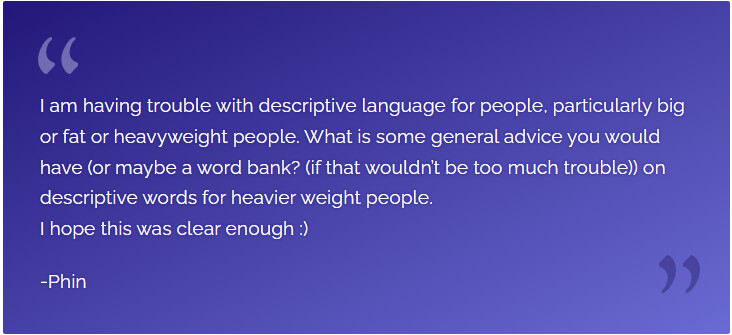I recently came across comments in the apartment discussion where some viewers were challenged for the way they described some participants, because they felt their descriptions caused offence. I came across this article which I thought was interesting and some of you as I will, may find useful. Enjoy!
Thanks for the question! This is something I think about a lot, and the fact that we live in a fatphobic culture makes it tricky.
An important part of respectfully describing fat characters is describing thin characters in value-neutral ways. Avoid using thinness as a synonym for unrelated positive traits, like being beautiful or athletic. It also means not treating thinness like it is normal. If a character is thin, describe them as thin. In addition, there are many different thin body types. Describing the different body types of thin characters makes thinness less idealized. For example, a thin character could be lanky, wiry, angular, petite, bony, slender, gangly, scrawny, or willowy.
It is particularly important to separate the idea of being athletic, fit, and healthy from thinness. There are plenty of thin people who aren’t athletic, and there are plenty of fat people who are. For anyone who doubts this fact, please do some research on fat athletes. This isn’t a perfect article, but you can start with Daily News: Can you be fat and fit? These plus-size athletes say yes by Nicole Lyn Pesce. Instead of using words like “athletic” as synonyms for thinness, use them to mean what they actually mean – being physically strong and active. This frees up words like energetic, muscular, nimble, brawny, limber, agile, and tough so that they can be used for characters of any size.
When it comes to describing fat characters, don’t avoid using the word “fat.” This is a word with a lot of cultural baggage that’s important to be aware of, but avoiding the word “fat” can be stigmatizing. When you avoid saying “fat” in a context where its use is appropriate, it creates the feeling that being fat is such a terrible thing that you can’t even say the word. However, do be aware that there is still a lot of stigma attached to “fat,” and this stigma can lead people to interpret it negatively when it is used in neutral situations.
There are a lot of other words, like “curvy,” “generous,” and “cushy,” that people use to describe fat characters. When using these words, it is important to notice the distinction between using a word as a euphemism for fatness and using it as a specific description of a character’s body. A lot of this comes down to context, though some words have a stronger association with being a euphemism than others. For example, the word “curvy” can be used as a euphemism to avoid calling someone fat, or it can be used to describe a specific body shape that is separate from being fat or thin.
That said, it is important to be aware that which words feel like euphemisms and which words feel like positive descriptions of fat characters vary from reader to reader. Some people have negative associations with the word “curvy” that come from both its use as a euphemism and its use in contexts where women are objectified. Because the nuances of this can get tricky, I suggest hiring a fat-positive sensitivity reader if you can afford one.
In addition, it’s important to have ways to describe characters’ body shapes that aren’t focused on their size. This is because exclusively describing characters by focusing on whether they are fat or thin is reductive. It sends the message that size is the only thing that matters about peoples’ bodies. One place I regularly use for inspiration on this is the many online lists of different body shapes. A few of the body shapes, like having an oval body, can be used directly, but mostly it’s the way the body shapes are explained, like having wide hips or broad shoulders, that is useful.
Body shape lists are most easily found by searching for “Women’s Body Shapes” and “Men’s Body Shapes.” When using these lists, please keep in mind that they are gender essentialist and ignore the existence of trans and nonbinary people. In addition, some of the ways they talk about women’s bodies aren’t great. For example, it is disrespectful to objectify women or compare any part of a woman’s body to food, especially for women of color.
Finally, I recommend checking out Sarah Howell: A Guide for Skinny Writers Who Want to Write Fat Characters. It has a great discussion of some of these issues along with some useful references. For a list of words, you can check out Prospect Therapy: 40 Kind and Positive Words for Your Body by Lindley and Fatadelic: A page full of positive synonyms of ‘fat’. Again, keep in mind that the words and phrases on these lists are extremely context-dependent.
I hope this helps!


